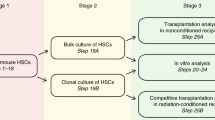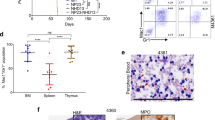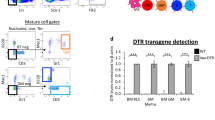Abstract
Investigation of immune-cell differentiation and function is limited by shortcomings of suitable and scalable experimental systems. Here we show that retroviral delivery of an estrogen-regulated form of Hoxb8 into mouse bone marrow cells can be used along with Flt3 ligand to conditionally immortalize early hematopoietic progenitor cells (Hoxb8-FL cells). Hoxb8-FL cells have lost self-renewal capacity and potential to differentiate into megakaryocytes and erythrocytes but retain the potential to differentiate into myeloid and lymphoid cells. They differentiate in vitro and in vivo into macrophages, granulocytes, dendritic cells, B lymphocytes and T lymphocytes that are phenotypically and functionally indistinguishable from their primary counterparts. Quantitative in vitro assays indicate that myeloid and B-cell potential of Hoxb8-FL cells is comparable to that of primary lymphoid-primed multipotent progenitors, whereas T-cell potential is diminished. The simplicity of this system and the unlimited proliferative capacity of Hoxb8-FL cells will enable studies of immune-cell differentiation and function.
This is a preview of subscription content, access via your institution
Access options
Subscribe to this journal
Receive 12 print issues and online access
$259.00 per year
only $21.58 per issue
Buy this article
- Purchase on Springer Link
- Instant access to full article PDF
Prices may be subject to local taxes which are calculated during checkout






Similar content being viewed by others
References
Argiropoulos, B. & Humphries, R.K. Hox genes in hematopoiesis and leukemogenesis. Oncogene 26, 6766–6776 (2007).
Pineault, N., Helgason, C.D., Lawrence, H.J. & Humphries, R.K. Differential expression of Hox, Meis1, and Pbx1 genes in primitive cells throughout murine hematopoietic ontogeny. Exp. Hematol. 30, 49–57 (2002).
Wang, G.G. et al. Quantitative production of macrophages or neutrophils ex vivo using conditional Hoxb8. Nat. Methods 3, 287–293 (2006).
McKenna, H.J. et al. Mice lacking flt3 ligand have deficient hematopoiesis affecting hematopoietic progenitor cells, dendritic cells, and natural killer cells. Blood 95, 3489–3497 (2000).
Gilliet, M. et al. The development of murine plasmacytoid dendritic cell precursors is differentially regulated by Flt3-ligand and granulocyte/macrophage colony-stimulating factor. J. Exp. Med. 195, 953–958 (2002).
Steinman, R.M. Dendritic cells: understanding immunogenicity. Eur. J. Immunol. 37 (suppl. 1), S53–S60 (2007).
Naik, S.H. et al. Cutting edge: generation of splenic CD8+ and CD8− dendritic cell equivalents in Fms-like tyrosine kinase 3 ligand bone marrow cultures. J. Immunol. 174, 6592–6597 (2005).
Hemmi, H., Kaisho, T., Takeda, K. & Akira, S. The roles of Toll-like receptor 9, MyD88, and DNA-dependent protein kinase catalytic subunit in the effects of two distinct CpG DNAs on dendritic cell subsets. J. Immunol. 170, 3059–3064 (2003).
Hogquist, K.A. et al. T cell receptor antagonist peptides induce positive selection. Cell 76, 17–27 (1994).
Barnden, M.J., Allison, J., Heath, W.R. & Carbone, F.R. Defective TCR expression in transgenic mice constructed using cDNA-based alpha- and beta-chain genes under the control of heterologous regulatory elements. Immunol. Cell Biol. 76, 34–40 (1998).
Sitnicka, E. et al. Key role of flt3 ligand in regulation of the common lymphoid progenitor but not in maintenance of the hematopoietic stem cell pool. Immunity 17, 463–472 (2002).
Hardy, R.R., Carmack, C.E., Shinton, S.A., Kemp, J.D. & Hayakawa, K. Resolution and characterization of pro-B and pre-pro-B cell stages in normal mouse bone marrow. J. Exp. Med. 173, 1213–1225 (1991).
Zlotoff, D.A. et al. Delivery of progenitors to the thymus limits T-lineage reconstitution after bone marrow transplantation. Blood 118, 1962–1970 (2011).
Prockop, S.E. & Petrie, H.T. Regulation of thymus size by competition for stromal niches among early T cell progenitors. J. Immunol. 173, 1604–1611 (2004).
Carlyle, J.R. et al. Identification of a novel developmental stage marking lineage commitment of progenitor thymocytes. J. Exp. Med. 186, 173–182 (1997).
Schmitt, T.M. & Zuniga-Pflucker, J.C. Induction of T cell development from hematopoietic progenitor cells by delta-like-1 in vitro. Immunity 17, 749–756 (2002).
Godfrey, D.I., Kennedy, J., Suda, T. & Zlotnik, A. A developmental pathway involving four phenotypically and functionally distinct subsets of CD3–CD4-CD8- triple-negative adult mouse thymocytes defined by CD44 and CD25 expression. J. Immunol. 150, 4244–4252 (1993).
Pui, J.C. et al. Notch1 expression in early lymphopoiesis influences B versus T lineage determination. Immunity 11, 299–308 (1999).
Sultana, D.A., Bell, J.J., Zlotoff, D.A., De Obaldia, M.E. & Bhandoola, A. Eliciting the T cell fate with Notch. Semin. Immunol. 22, 254–260 (2010).
Wada, H. et al. Adult T-cell progenitors retain myeloid potential. Nature 452, 768–772 (2008).
Bell, J.J. & Bhandoola, A. The earliest thymic progenitors for T cells possess myeloid lineage potential. Nature 452, 764–767 (2008).
Luc, S. et al. The earliest thymic T cell progenitors sustain B cell and myeloid lineage potential. Nat. Immunol. 13, 412–419 (2012).
Adolfsson, J. et al. Identification of Flt3+ lympho-myeloid stem cells lacking erythro-megakaryocytic potential a revised road map for adult blood lineage commitment. Cell 121, 295–306 (2005).
Yang, L. et al. Identification of Lin(−)Sca1(+)kit(+)CD34(+)Flt3− short-term hematopoietic stem cells capable of rapidly reconstituting and rescuing myeloablated transplant recipients. Blood 105, 2717–2723 (2005).
Oshima, S. et al. ABIN-1 is a ubiquitin sensor that restricts cell death and sustains embryonic development. Nature 457, 906–909 (2009).
Zhou, J. et al. A20-binding inhibitor of NF-kappaB (ABIN1) controls Toll-like receptor-mediated CCAAT/enhancer-binding protein beta activation and protects from inflammatory disease. Proc. Natl. Acad. Sci. USA 108, E998–E1006 (2011).
Mauro, C. et al. ABIN-1 binds to NEMO/IKKgamma and co-operates with A20 in inhibiting NF-kappaB. J. Biol. Chem. 281, 18482–18488 (2006).
Cohen, S., Ciechanover, A., Kravtsova-Ivantsiv, Y., Lapid, D. & Lahav-Baratz, S. ABIN-1 negatively regulates NF-kappaB by inhibiting processing of the p105 precursor. Biochem. Biophys. Res. Commun. 389, 205–210 (2009).
Arinobu, Y. et al. Reciprocal activation of GATA-1 and PU.1 marks initial specification of hematopoietic stem cells into myeloerythroid and myelolymphoid lineages. Cell Stem Cell 1, 416–427 (2007).
Wallis, V.J., Leuchars, E., Chwalinski, S. & Davies, A.J. On the sparse seeding of bone marrow and thymus in radiation chimaeras. Transplantation 19, 2–11 (1975).
Spangrude, G.J. & Scollay, R. Differentiation of hematopoietic stem cells in irradiated mouse thymic lobes. Kinetics and phenotype of progeny. J. Immunol. 145, 3661–3668 (1990).
Zlotoff, D.A. et al. CCR7 and CCR9 together recruit hematopoietic progenitors to the adult thymus. Blood 115, 1897–1905 (2010).
Foss, D.L., Donskoy, E. & Goldschneider, I. The importation of hematogenous precursors by the thymus is a gated phenomenon in normal adult mice. J. Exp. Med. 193, 365–374 (2001).
Serwold, T., Ehrlich, L.I. & Weissman, I.L. Reductive isolation from bone marrow and blood implicates common lymphoid progenitors as the major source of thymopoiesis. Blood 113, 807–815 (2009).
Stuehr, D.J. & Nathan, C.F. Nitric oxide. A macrophage product responsible for cytostasis and respiratory inhibition in tumor target cells. J. Exp. Med. 169, 1543–1555 (1989).
Tora, L. et al. The cloned human oestrogen receptor contains a mutation which alters its hormone binding properties. EMBO J. 8, 1981–1986 (1989).
Schmitt, T.M. & Zuniga-Pflucker, J.C. T-cell development, doing it in a dish. Immunol. Rev. 209, 95–102 (2006).
Hu, Y. & Smyth, G.K. ELDA: extreme limiting dilution analysis for comparing depleted and enriched populations in stem cell and other assays. J. Immunol. Methods 347, 70–78 (2009).
Loeffler, D.I., Schoen, C.U., Goebel, W. & Pilgrim, S. Comparison of different live vaccine strategies in vivo for delivery of protein antigen or antigen-encoding DNA and mRNA by virulence-attenuated Listeria monocytogenes. Infect. Immun. 74, 3946–3957 (2006).
Di Tullio, A. et al. CCAAT/enhancer binding protein alpha (C/EBP(alpha))-induced transdifferentiation of pre-B cells into macrophages involves no overt retrodifferentiation. Proc. Natl. Acad. Sci. USA 108, 17016–17021 (2011).
Acknowledgements
We thank the staff of the Animal Resource Center, the Flow Cytometry and Cell Sorting Resource, and the Proteomics and Mass Spectrometry laboratory at the St. Jude Children's Research Hospital and L. Chi for technical assistance; and H. Hochrein for helpful discussion related to dendritic cell biology. Supported by National Institutes of Health National Institute of Allergy and Infectious Diseases grant AI083443 to H.H., the National Institutes of Health National Cancer Institute grant P30CA021765 and the American Lebanese Syrian Associated Charities. We thank M. Kamps (Univ. California, San Diego) for the SCF-producing B16 melanoma cell line, R. Steinman (Rockefeller Univ.) for the Flt3L-producing B16 melanoma cell line, S. Zandi and M. Sigvardsson (Linköping Univ.) and D. Bryder (Lund Univ.) for hematopoietic progenitor cell markers, and W. Goebel and D. Loeffler (Univ. Würzburg) for ovalbumin-encoding cDNA.
Author information
Authors and Affiliations
Contributions
V.R., R.W., V.C. and H.H. planned experiments; V.R., R.W., J.Z., V.C. and H.H. performed experiments; A.A.H., D.F., V.C., V.R. and H.H. analyzed data; V.R. and H.H. wrote the manuscript; and H.H. conceived the project.
Corresponding author
Ethics declarations
Competing interests
The authors declare no competing financial interests.
Supplementary information
Supplementary Text and Figures
Supplementary Figures 1–13, Supplementary Table 1 (PDF 1539 kb)
Rights and permissions
About this article
Cite this article
Redecke, V., Wu, R., Zhou, J. et al. Hematopoietic progenitor cell lines with myeloid and lymphoid potential. Nat Methods 10, 795–803 (2013). https://doi.org/10.1038/nmeth.2510
Received:
Accepted:
Published:
Issue Date:
DOI: https://doi.org/10.1038/nmeth.2510
This article is cited by
-
Identifying the tumor immune microenvironment-associated prognostic genes for prostate cancer
Discover Oncology (2024)
-
The AML-associated K313 mutation enhances C/EBPα activity by leading to C/EBPα overexpression
Cell Death & Disease (2021)
-
Lysosome repositioning as an autophagy escape mechanism by Mycobacterium tuberculosis Beijing strain
Scientific Reports (2021)
-
Importance of Bcl-2-family proteins in murine hematopoietic progenitor and early B cells
Cell Death & Disease (2021)
-
Chromatin accessibility promotes hematopoietic and leukemia stem cell activity
Nature Communications (2020)



